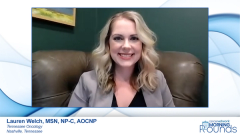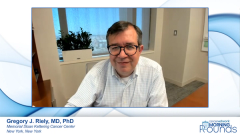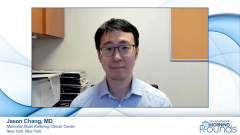
Optimizing Molecular Testing in Patients With Non-Small Cell Lung Cancer
Closing out their discussion on NSCLC biomarker testing assay selection, panelists consider the optimal use of these assays in their own patients.
Episodes in this series

Transcript:
Gregory J. Riely, MD, PhD: I think you mentioned some testing that we do in house here at MSK [Memorial Sloan Kettering Cancer Center]. I would guess that most institutions are moving away from in-house assays, particularly for these larger NGS [next-generation sequencing]-type approaches. Is that the trend?
Jason Chang, MD: I would agree with you on that. It is very difficult for all institutions or laboratories to have their own large panel NGS. They might offer something smaller, like a 50-gene panel NGS. But if they wanted to pursue something like a larger panel NGS, over 100 or 200 genes, then most of the time, they would consider sending the tissue out to commercial labs for that purpose.
Gregory J. Riely, MD, PhD: Thinking specifically of the testing of plasma DNA, it seems like that definitely is a place where sending it out is more the usual than doing it in house.
Jason Chang, MD: Definitely, I would agree with you on that.
Gregory J. Riely, MD, PhD: When you’re in the pathology lab or your team is there, what are the specimens you get that you’re going to use to get that tumor testing done? Sometimes you get a block, sometimes you get unstained slides; some of the unstained slides don’t have any tumor on them, and some have lots of tumors. How do you deal with that?
Jason Chang, MD: We do the best we can. We must assess the slides first to make sure there is tumor in the slide and block. Then we have to assess for tumor purity to make sure there are sufficient tumor cells in relation to background stromal cells and lymphocytes. Otherwise, if there are a lot of non-neoplastic cells, despite tumor being present on the slides, it may not be adequate for molecular testing purposes. For blocks, we have to obtain an initial H&E [hematoxylin and eosin stain] to do a histologic evaluation first. Those things would all account for some of the delays that may occur before the tissue even arrives in the molecular lab. In addition to the molecular lab, some of the biomarkers can be done using immunochemistry [IHC], for example, PD-L1 and ALK, those are probably the 2 major ones. Sometimes we may have to order more stains in addition to completing molecular testing.
Gregory J. Riely, MD, PhD: Right. We haven’t spent a lot of time so far talking about PD-L1. I know there are a lot of different antibodies and different testing systems that people use. From an oncologist’s perspective, what would you want us to know about PD-L1 testing? What I’m getting at is, how important do you think the various antibody choices are? Is it less important what the antibody is and more important that the laboratory has validated whatever they have?
Jason Chang, MD: Right. There are different clones of the antibody assay out there. It is up to each individual laboratory to validate their own assay to make sure it shows good concordance with the published recommended assay.
Gregory J. Riely, MD, PhD: I think that’s reasonable. The IHC we mostly look at for, say TTF-1 and napsin [markers], the classic histology-defining IHC. We get a positive or negative result basically. But you don’t do that for PD-L1.
Jason Chang, MD: We have a quantitative score for PD-L1, and your treatment decision also depends on the specific cutoffs for the PD-L1 scores. It can be somewhat subjective as well because of the variability in the intensity of staining, it is not cut and dried for the interpretation. There is some subjectivity involved as well, but we try to do our best in interpreting that.
Gregory J. Riely, MD, PhD: How do you get to the percentage that I see in that report? When I look down there and it says 5% or 80%, how do you get there?
Jason Chang, MD: To be honest, it’s our best eyeball estimation. However, there are computational algorithms out there in development. Hopefully, in the future we’ll have a standardized machine-interpreted algorithm out there.
Gregory J. Riely, MD, PhD: Sounds better than having to count cells, right?
Jason Chang, MD: For sure.
Transcript edited for clarity.
Newsletter
Stay up to date on recent advances in the multidisciplinary approach to cancer.





















































































